Death Valley National Park contains arguably the most diverse set of geologic features per square mile than any other national park in the world. Among the highlights are the Ubehebe volcanic field and Titus Canyon. The Ubehebe (you-bee-hee-bee) volcanic field is a classic example of a phreatomagmatic eruption. A phreatomagmatic eruption occurs when rising magma comes in contact with groundwater causing a violent explosion as the water instantly boils and erupts lava and steam to the surface. As this eruptions rips to the surface, it tears at the country rock adjacent to the vent throwing a mixture of ash, scoria, and sedimentary rock out of the crater.
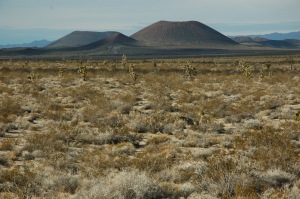 |
| Ubehebe (right) and little Hebe (left) with the iconic Joshua trees in the foreground |
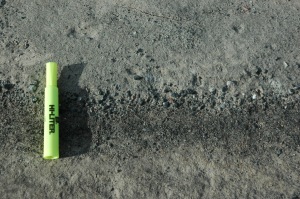 |
| Mixture of ash, scoria, and country rock |
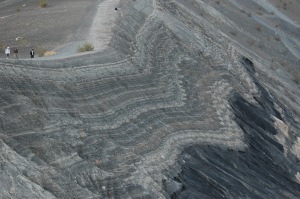 |
| Layers of ashfall and lapilli |
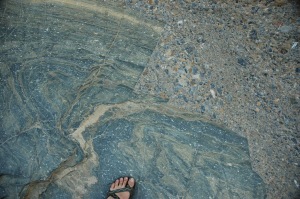 |
| This is a photograph of river bottom that has polished this surface. The folded marble (left) is cut with conspicuously straight edges and covered with a conglomerate (right) now metamorphosed and polished. Really bizarre stuff. |
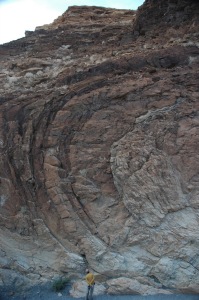 |
| All of the sedimentary units in Titus Canyon are overturned. At the top of the canyon we see where it all begins. The rocks left of Kellen are all overturned and the rocks above and right of Kellen are ride-side-up. |
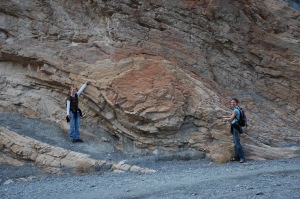 |
| Anne and Coreen posing with a spectacular boudin. |
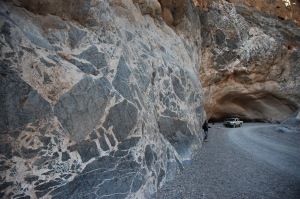 |
| Further up the canyon, the Bonanza King Formation forms this “megabreccia” and has travertine infilling the fractures. |
 |
| Here is where things get really strange. In the last photo is looks like the travertine is flowing into the marble, possibly causing the brecciation. However in this photo (and the next) the marble is breaking up and flowing into the travertine. |
 |
| Grey marble flowing into white travertine. |
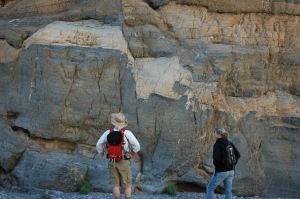 |
| Deformation in Titus seems to blur the line between ductile and brittle deformation. In some places (shown above) it is nearly all clearly brittle deformation, however in this photograph there is both brittle deformation as well as ductile flow. Click on photo to get a closer view. |
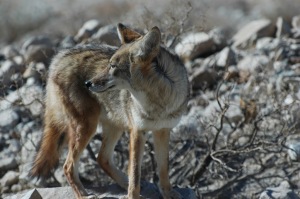 |
| A hungry coyote not afraid to wait by the roadside for passerby’s to toss him some scraps. |
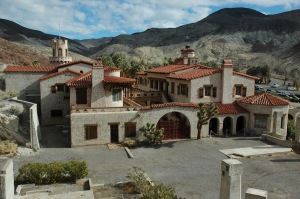 |
| Scotty’s Castle built in 1922 for $2 million dollars and then sold in 1970 to the National Park for $850,000. |
 |
| One last interesting site in Death Valley is Mars Hill. This basalt covered hill was the training ground for NASA Mars Pathfinder Rover. Because this hill is very similar to much of the landscape the Pathfinder was to encounter, NASA created a 5 cm digital elevation model of this hill to guide the rover through this complicated landscape. When I went there with the Jet Propulsion Laboratory, they told us not to move any of the rocks because then the DEM would be inaccurate. |
The other highlight of Death Valley geology is Titus Canyon. Cut into the Grapevine Mountains, Titus canyon exposes the Cambrian Zabriskie, Carrara, and Bonanza King Formations. These formations represent the Great Sauk Transgression and similar formations are found throughout Laurentia (even here in Scotland). The most interesting part of Titus Canyon is not this transgressive sequence tract, but rather the spectacular deformation that occurred hundreds of million years later.
 This work is licensed under a Creative Commons Attribution-NonCommercial-ShareAlike 4.0 International License.
This work is licensed under a Creative Commons Attribution-NonCommercial-ShareAlike 4.0 International License.








![]() This work is licensed under a Creative Commons Attribution-NonCommercial-ShareAlike 4.0 International License.
This work is licensed under a Creative Commons Attribution-NonCommercial-ShareAlike 4.0 International License.




